Muscular training
We suggest performing the exercises in 3 sets of 10 repetitions and alternating when all is done one arm at a time. The weight load or the resistance of the elastics band remains your choice. To find out if you are using the right resistance, you have to go for the LAST repetition… the one that causes you heat in the muscle. With this advice, you ensure that you get enough strength to get better results in your training. It is important to listen to your body and adapt the exercises to your abilities.
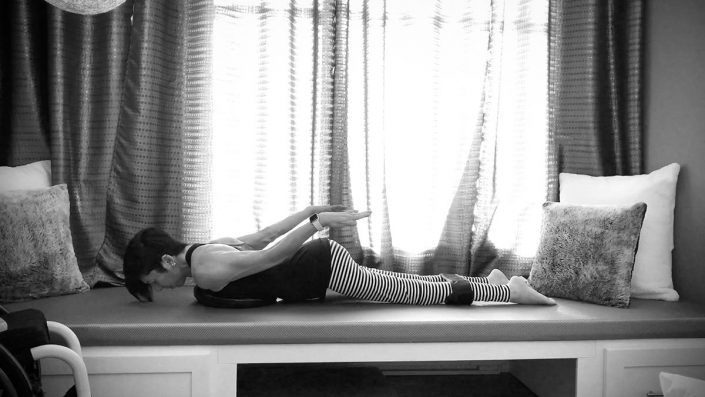
Reverse wingsuit
• Main muscles: deltoids, rhomboids, latissimus dorsi
• Start: Hold the feet together using a strap (to prevent the legs from moving). Place the balance disk under the chest.
• Movement: Arm along the body. Hand palms facing the GROUND. Raise as high as possible in what the mobility of the shoulder allows to do. Hold for 15 seconds.
• 3 x 15 seconds
• Start: Hold the feet together using a strap (to prevent the legs from moving). Place the balance disk under the chest.
• Movement: Arm along the body. Hand palms facing the GROUND. Raise as high as possible in what the mobility of the shoulder allows to do. Hold for 15 seconds.
• 3 x 15 seconds
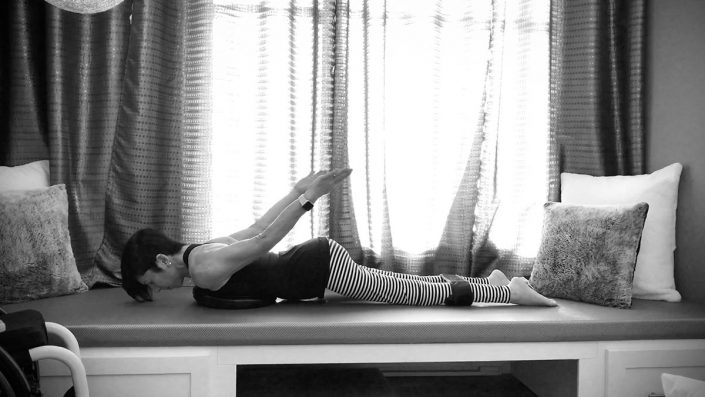
Wingsuit
• Main muscles: deltoids, rhomboids, latissimus dorsi
• Start: Hold the feet together using a strap (to prevent the legs from moving). Place the balance disk under the chest.
• Movement: Arm along the body. Hand palms facing the SKY. Raise as high as possible in what the mobility of the shoulder allows to do. Hold for 15 seconds.
• 3 x 15 seconds
• Start: Hold the feet together using a strap (to prevent the legs from moving). Place the balance disk under the chest.
• Movement: Arm along the body. Hand palms facing the SKY. Raise as high as possible in what the mobility of the shoulder allows to do. Hold for 15 seconds.
• 3 x 15 seconds
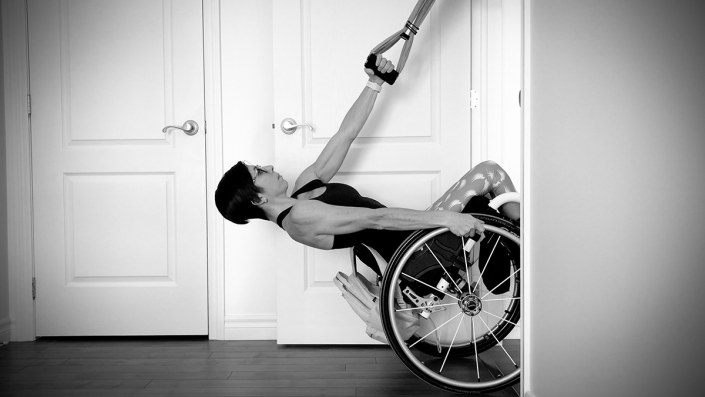
Rowing one arm -TRX
• Main muscles: Latissimus dorsi, biceps
• Start: Place the chair under the handles. Apply BRAKES. Grip the two handles firmly and transfer the weight backwards until the chair is tilted backwards.
• Movement: Pull the handles towards the shoulder, keeping your elbows as stable as possible. Execute movement slowly for better control.
• Tip: Adjust the length of the strap according to your height and the desired difficulty
• 3 x 10 reps
• Start: Place the chair under the handles. Apply BRAKES. Grip the two handles firmly and transfer the weight backwards until the chair is tilted backwards.
• Movement: Pull the handles towards the shoulder, keeping your elbows as stable as possible. Execute movement slowly for better control.
• Tip: Adjust the length of the strap according to your height and the desired difficulty
• 3 x 10 reps
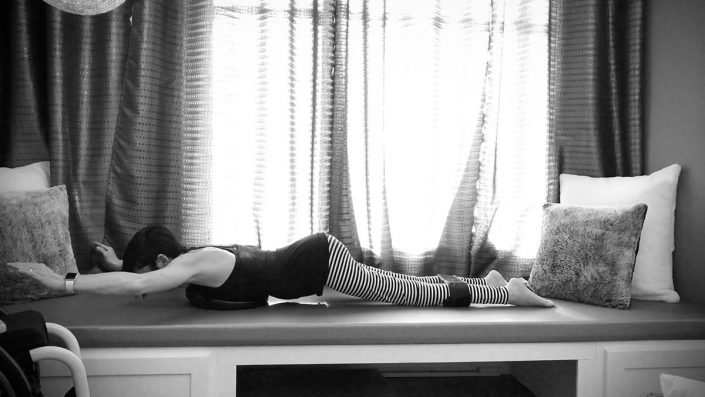
The V
• Main muscles: Trapezius and deltoids
• Start: Hold the feet together using a strap (to prevent the legs from moving). Place the balance disk under the chest.
• Movement: Position of the arms in V. Arms on the ground or raised according to the mobility of the shoulder. Hold for 15 seconds.
• 3 x 15 seconds
• Start: Hold the feet together using a strap (to prevent the legs from moving). Place the balance disk under the chest.
• Movement: Position of the arms in V. Arms on the ground or raised according to the mobility of the shoulder. Hold for 15 seconds.
• 3 x 15 seconds
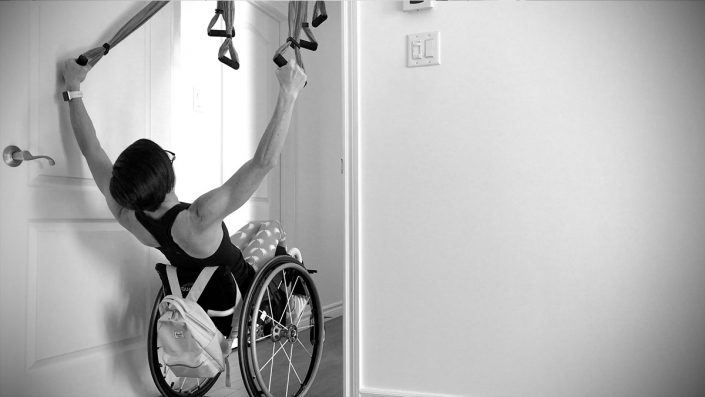
Reverse fly – TRX
*** WARNING *** It is recommended to do this exercise with assistance to start
• Main muscles: Posterior deltoids, trapezius and rhomboids
• Start: Place the chair under the handles. Lock BRAKES. Grasp the handles firmly and transfer the weight backwards until the chair is tilted backwards. Place the arms fully extended to start.
• Movement: Pull the handles towards the ceiling, as much as possible, without bending your elbows. Control the return movement. Resist the urge to move your head forward OR lift your shoulders.
• Tip: Adjust the length of the strap according to your height and the desired difficulty
• Main muscles: Posterior deltoids, trapezius and rhomboids
• Start: Place the chair under the handles. Lock BRAKES. Grasp the handles firmly and transfer the weight backwards until the chair is tilted backwards. Place the arms fully extended to start.
• Movement: Pull the handles towards the ceiling, as much as possible, without bending your elbows. Control the return movement. Resist the urge to move your head forward OR lift your shoulders.
• Tip: Adjust the length of the strap according to your height and the desired difficulty
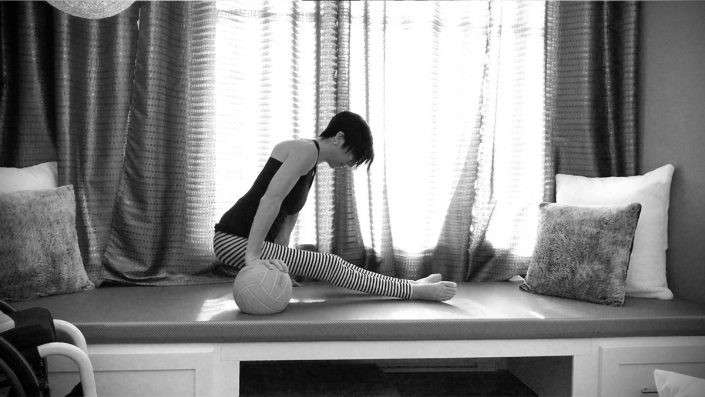
Ball dips
*REQUIREMENT* To have successfully completed the "balance of the shoulder" before undertaking this one.
• Main muscles: Triceps, serratus anterior, stabilizers of the shoulder
• Start: Balloon next to the hip. Hand resting on the ball, fingers pointing forward.
• Movement: Push into the ground with your hands until the buttocks are lifted (one hand is unstable on the ball, the other is stable on the ground).
• Tip # 1: Remember to push on the ball instead of lifting your shoulder for successful exercise.
• Tip # 2: You can use a soccer or volley ball. Balloons that are too soft will add more difficulty in execution.
• 3 x 5 repetitions / arm. Increase the number of repetitions when the movement seems easier.
• Main muscles: Triceps, serratus anterior, stabilizers of the shoulder
• Start: Balloon next to the hip. Hand resting on the ball, fingers pointing forward.
• Movement: Push into the ground with your hands until the buttocks are lifted (one hand is unstable on the ball, the other is stable on the ground).
• Tip # 1: Remember to push on the ball instead of lifting your shoulder for successful exercise.
• Tip # 2: You can use a soccer or volley ball. Balloons that are too soft will add more difficulty in execution.
• 3 x 5 repetitions / arm. Increase the number of repetitions when the movement seems easier.
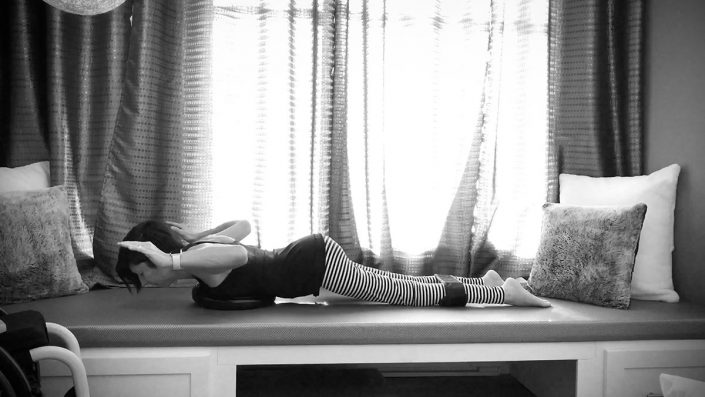
The W
• Main muscles: Rhomboids and external shoulder rotators
• Start: Hold the feet together using a strap (to prevent the legs from moving). Place the balance disk under the chest.
• Movement: 90 ° elbows. Bring the shoulder blades together by lifting the hands and elbows from the floor (to form a W). Hold for 15 seconds.
• 3 x 15 seconds
• Start: Hold the feet together using a strap (to prevent the legs from moving). Place the balance disk under the chest.
• Movement: 90 ° elbows. Bring the shoulder blades together by lifting the hands and elbows from the floor (to form a W). Hold for 15 seconds.
• 3 x 15 seconds
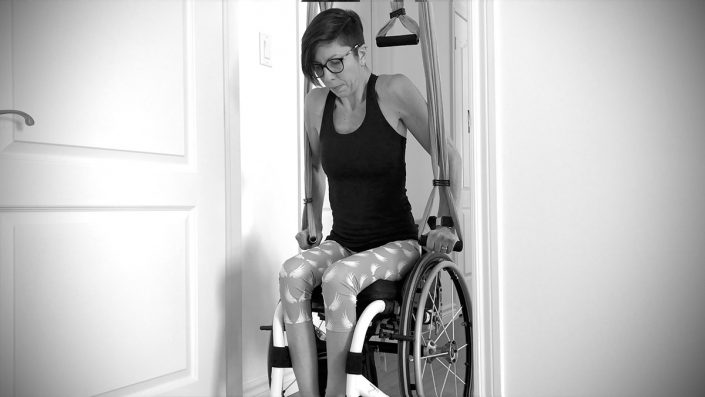
Dips-TRX
*REQUIREMENT* To have successfully "Extended the elbows on TRX" before undertaking this one.
• Main muscles: Anterior dentate, triceps
• Start: Place the chair under the handles. Adjust the height of the handles so that they are close to the wheels.
• Movement: Raise the buttocks off the chair until the elbows are fully extended. Bend your elbows as low as possible, keeping the handles close to your body. Keep a slow pace for better performance.
• Tip: Remember to lower your shoulders to activate the serrated anterior (better stability). Keep hands close to the body to reduce the wobbling of the straps
• 3 x 5 repetitions
• Main muscles: Anterior dentate, triceps
• Start: Place the chair under the handles. Adjust the height of the handles so that they are close to the wheels.
• Movement: Raise the buttocks off the chair until the elbows are fully extended. Bend your elbows as low as possible, keeping the handles close to your body. Keep a slow pace for better performance.
• Tip: Remember to lower your shoulders to activate the serrated anterior (better stability). Keep hands close to the body to reduce the wobbling of the straps
• 3 x 5 repetitions
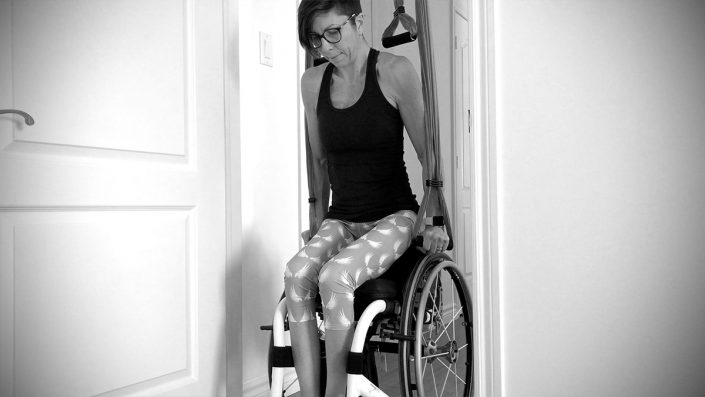
Elbow extension – TRX
• Main muscles: Serratus anterior, triceps
• Start: Place the chair under the handles. Adjust the height of the handles so that they are close to the wheels.
• Movement: Lift the buttocks of the chair until the elbows are fully extended. Maintain the static position.
• Tip: Remember to lower your shoulders to activate the serratus anterior (better stability). Keep hands close to the body to reduce the wobbling of the straps
• 3 x 10 to 15 seconds
• Start: Place the chair under the handles. Adjust the height of the handles so that they are close to the wheels.
• Movement: Lift the buttocks of the chair until the elbows are fully extended. Maintain the static position.
• Tip: Remember to lower your shoulders to activate the serratus anterior (better stability). Keep hands close to the body to reduce the wobbling of the straps
• 3 x 10 to 15 seconds
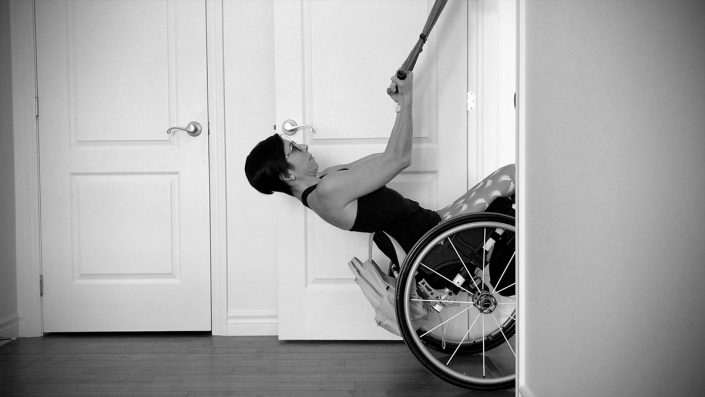
Biceps curl
*** WARNING *** It is recommended to do this exercise with assistance to start
• Main muscles: Biceps
• Start: Place the chair under the handles. Apply BRAKES. Grip the handles firmly and transfer the weight backwards until the chair is tilted backwards.
• Movement: Pull the handles towards the shoulders, keeping your elbows as stable as possible. Execute movement slowly for better control.
• Tip: Adjust the length of the strap according to your height and the desired difficulty
• Main muscles: Biceps
• Start: Place the chair under the handles. Apply BRAKES. Grip the handles firmly and transfer the weight backwards until the chair is tilted backwards.
• Movement: Pull the handles towards the shoulders, keeping your elbows as stable as possible. Execute movement slowly for better control.
• Tip: Adjust the length of the strap according to your height and the desired difficulty
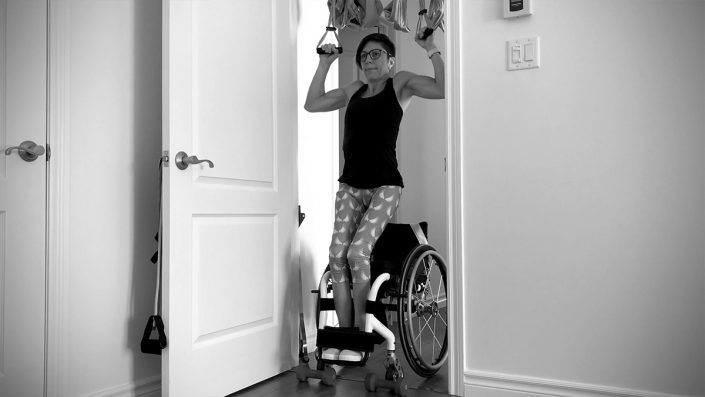
Chin up – level 2
• Departure: Arm in full extension, palms facing each other.
• Movement: Pull the weight of the body upwards until the chin is facing the hands. Descend slowly, controlling the descent.
• 3 x 5 repetitions to begin. You can vary the holds per group of repetitions. Palms backwards (biceps), palms forwards (triceps).
• Tip: To keep your feet in place, you can attach them to the footrest. You can also place something (free weights) in front of the small front wheels to prevent the chair from moving.
• Movement: Pull the weight of the body upwards until the chin is facing the hands. Descend slowly, controlling the descent.
• 3 x 5 repetitions to begin. You can vary the holds per group of repetitions. Palms backwards (biceps), palms forwards (triceps).
• Tip: To keep your feet in place, you can attach them to the footrest. You can also place something (free weights) in front of the small front wheels to prevent the chair from moving.
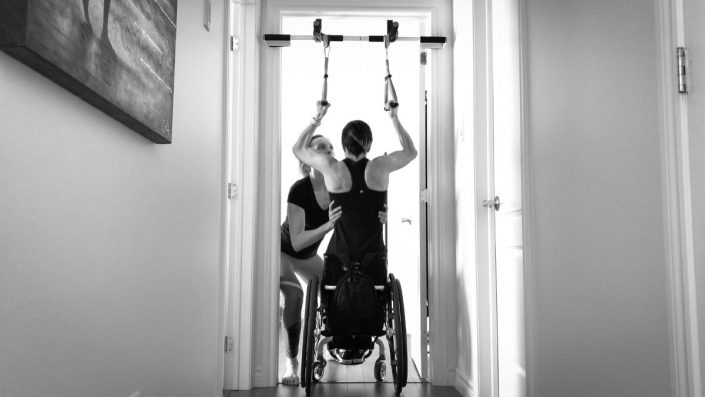
Chin up – level 1
• Departure: Arm in full extension, palms facing each other.
• Movement: With assistance, pull the weight of the body upwards until the chin is facing the hands. Descend slowly, controlling the descent.
• 3 x 5 repetitions to begin. You can vary the holds per group of repetitions. Palms backwards (biceps), palms forwards (triceps).
• Tip: To keep your feet in place, you can attach them to the footrest. You can also place something (free weights) in front of the small front wheels to prevent the chair from moving.
• Movement: With assistance, pull the weight of the body upwards until the chin is facing the hands. Descend slowly, controlling the descent.
• 3 x 5 repetitions to begin. You can vary the holds per group of repetitions. Palms backwards (biceps), palms forwards (triceps).
• Tip: To keep your feet in place, you can attach them to the footrest. You can also place something (free weights) in front of the small front wheels to prevent the chair from moving.
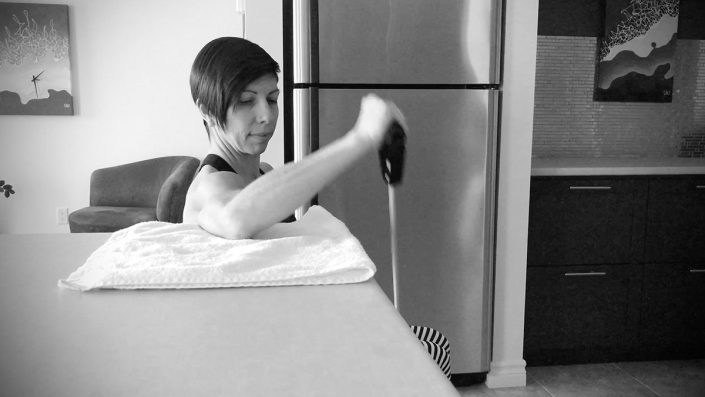
The rotator in support
• Main muscles: External rotator cuff (small round, infraspinatus)
• Start: Elbow resting on a table or counter (about shoulder height). Pass the rubber band under a bar of the chair and hold the other end with your free hand.
• Movement: Keep your elbow at 90° during the movement. Respect your range of motion without trying to force the movement. Keep the shoulder low at all times.
• Tip: Place a towel under your elbow for better comfort.
• Start: Elbow resting on a table or counter (about shoulder height). Pass the rubber band under a bar of the chair and hold the other end with your free hand.
• Movement: Keep your elbow at 90° during the movement. Respect your range of motion without trying to force the movement. Keep the shoulder low at all times.
• Tip: Place a towel under your elbow for better comfort.
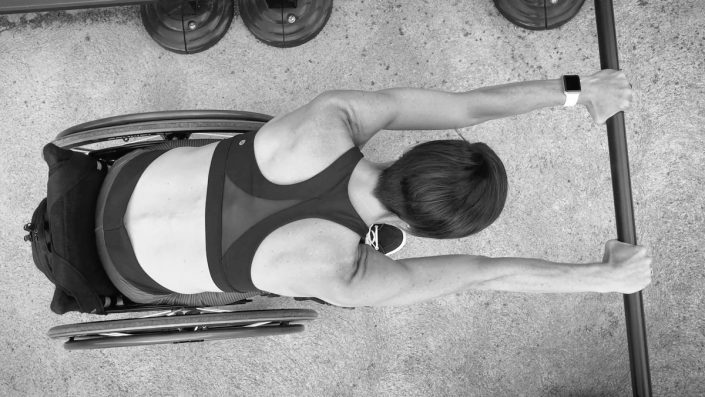
Protraction/Retraction of shoulder blades – level 2
• Main muscles: Serratus anterior and shoulder blade stabilizers
• Start: Grasp the bar with both hands. Lower shoulder blades and elbows in full extension.
• Movement: Climb up and down the shoulders without bending the elbows (as if to say "I don't know")
• Tip: The movement may be small at first, but the more you do this movement, the more mobile your shoulders will become.
• Start: Grasp the bar with both hands. Lower shoulder blades and elbows in full extension.
• Movement: Climb up and down the shoulders without bending the elbows (as if to say "I don't know")
• Tip: The movement may be small at first, but the more you do this movement, the more mobile your shoulders will become.
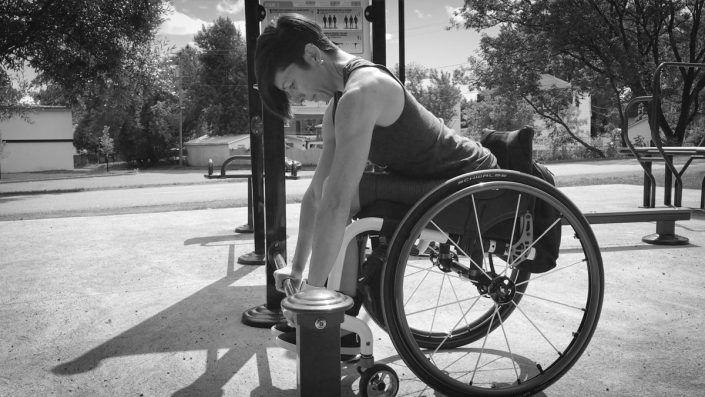
Protraction/Retraction of shoulder blades – level 1
• Main muscles: Serratus anterior and shoulder blade stabilizers
• Start: Grasp the bar with both hands. Lower shoulder blades and elbows in full extension.
• Movement: Climb up and down the shoulders without bending the elbows (as if to say "I don't know")
• Tip: The movement may be small at first, but the more you do this movement, the more mobile your shoulders will become.
• Start: Grasp the bar with both hands. Lower shoulder blades and elbows in full extension.
• Movement: Climb up and down the shoulders without bending the elbows (as if to say "I don't know")
• Tip: The movement may be small at first, but the more you do this movement, the more mobile your shoulders will become.
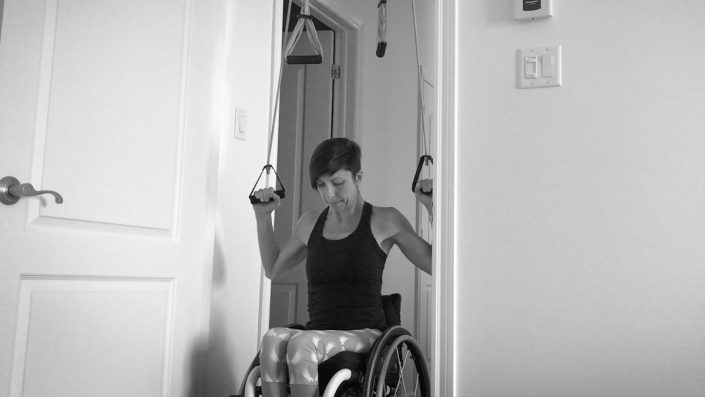
Tirade (wide grip)
• Main muscle: Latissimus Dorsi / Secondary muscles: Biceps and Large round
• Start: arm in extension, Elastic grip at shoulder width.
• Movement: Lower the elbows to the floor and slow down the movement on the way up. Go up to the full extension of the elbows.
• Tip: Keep shoulder blades low at all times
• Start: arm in extension, Elastic grip at shoulder width.
• Movement: Lower the elbows to the floor and slow down the movement on the way up. Go up to the full extension of the elbows.
• Tip: Keep shoulder blades low at all times
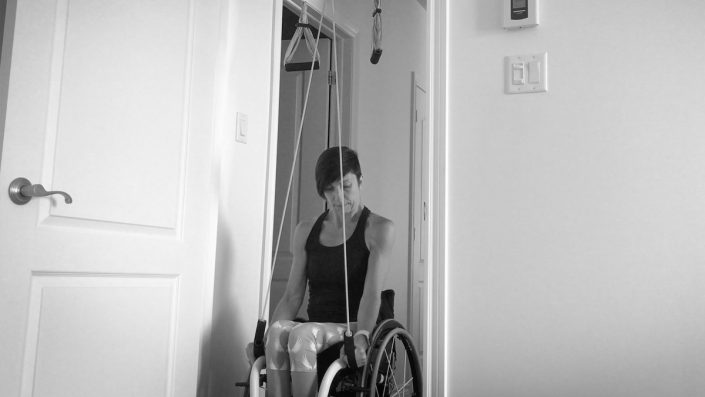
Triceps extension (ceiling anchor)
• Main muscle: Triceps
• Start: Elbow flexed and glued along the body on your trunk. The hand is in hammer action (thumb pointed towards the ceiling). The other handle is held by the free hand.
• Movement: Without moving the elbow, pull the elastic towards the floor until the elbow is fully extended. Control the movement back without bouncing the elastic on the ceiling or moving the elbow.
• Tip: Focus on elbow stability first. The movement will be easier to execute afterwards.
• Start: Elbow flexed and glued along the body on your trunk. The hand is in hammer action (thumb pointed towards the ceiling). The other handle is held by the free hand.
• Movement: Without moving the elbow, pull the elastic towards the floor until the elbow is fully extended. Control the movement back without bouncing the elastic on the ceiling or moving the elbow.
• Tip: Focus on elbow stability first. The movement will be easier to execute afterwards.
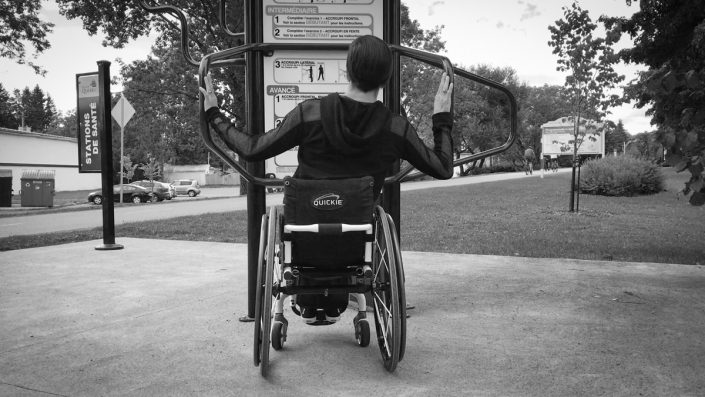
Lateral counter-resistance
• Main muscles: Deltoids and triceps
• Start: Place your hands on side bars (a door frame could also do the trick). Elbows pointing to the floor and shoulders down.
• Movement: With the left hand, push the body weight to the right. Meanwhile, the right arm is trying to slow down the movement of the opposite arm. Then do the reverse movement.
• Tip: It's like a battle between the two arms. To win the game, you have to keep the other one from returning to his territory.
• Start: Place your hands on side bars (a door frame could also do the trick). Elbows pointing to the floor and shoulders down.
• Movement: With the left hand, push the body weight to the right. Meanwhile, the right arm is trying to slow down the movement of the opposite arm. Then do the reverse movement.
• Tip: It's like a battle between the two arms. To win the game, you have to keep the other one from returning to his territory.
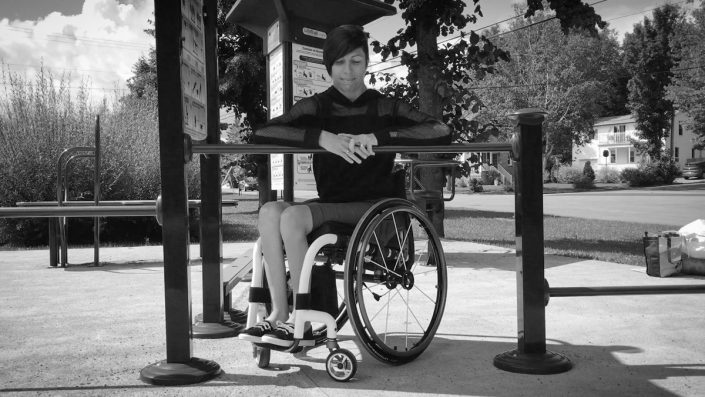
Trunk rotations
• Main muscles: Abdominal (transverse, oblique internal/external), serratus anterior/posterior, pectoral
• Start: Place the forearms against a bar, table or counter. Make sure that the support is not higher than the shoulders. Keep the trunk very close to the support so that your back can be vertical.
• Movement: Use the body weight to rotate the chair from left to right. Execute the movement slowly to start. The more control and strength you gain, the more speed you will gain.
• Start: Place the forearms against a bar, table or counter. Make sure that the support is not higher than the shoulders. Keep the trunk very close to the support so that your back can be vertical.
• Movement: Use the body weight to rotate the chair from left to right. Execute the movement slowly to start. The more control and strength you gain, the more speed you will gain.
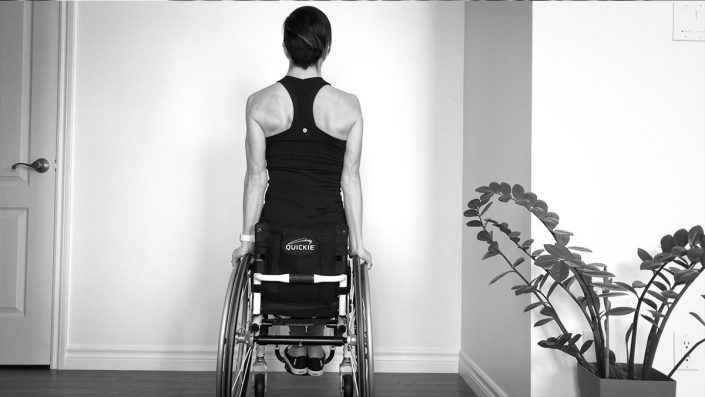
Shoulders push up
• Main muscle: Serratus anterior
• Start: Hands resting on the wheels. Elbows in full extension.
• Movement: Raise and lower the shoulders without bending your elbows (as if to imitate the "I do not know" sign). Resist the temptation to advance the shoulders forward
• Tip: Use a mirror to detect your motion errors by yourself
• Start: Hands resting on the wheels. Elbows in full extension.
• Movement: Raise and lower the shoulders without bending your elbows (as if to imitate the "I do not know" sign). Resist the temptation to advance the shoulders forward
• Tip: Use a mirror to detect your motion errors by yourself
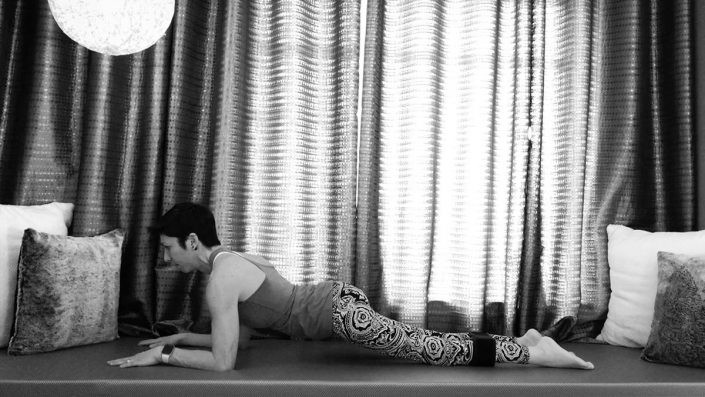
Push up scapulas
• Main muscles: Stabilizers of the scapula
• Start: Forearms placed on the ground. Elbows under the shoulders. Elbows at shoulder width. Make sure your feet are attached (if necessary) to prevent your legs from opening unnecessarily.
• Movement: Bring both shoulder blades together (as if pressing a lemon) and push into the ground with your elbows to widen the shoulder blades.
• Tip: The movement may be very small in the first few times you do it. The more you do it, the more mobility and stability you will gain in your shoulders.
• Start: Forearms placed on the ground. Elbows under the shoulders. Elbows at shoulder width. Make sure your feet are attached (if necessary) to prevent your legs from opening unnecessarily.
• Movement: Bring both shoulder blades together (as if pressing a lemon) and push into the ground with your elbows to widen the shoulder blades.
• Tip: The movement may be very small in the first few times you do it. The more you do it, the more mobility and stability you will gain in your shoulders.
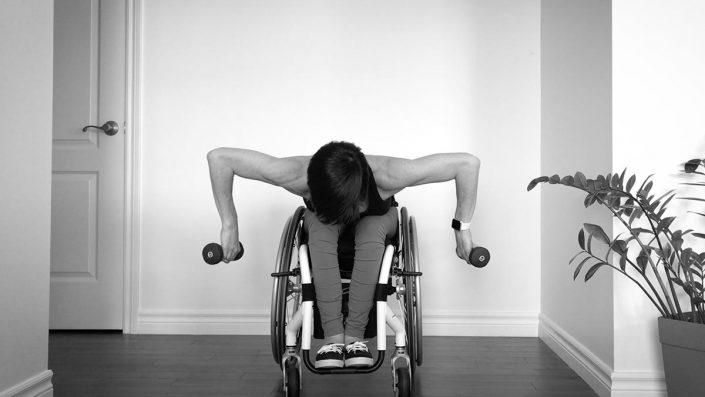
Inclined rowing external hands rotation
• Muscle: Posterior deltoids and rhomboids
• Start: Trunk inclined forward. Weights on the floor near the chair. Arms extended on each side of the body. Palm of hands facing outwards.
• Movement: Pull your elbows up to shoulder height. Move the weights away from your body during the rowing to try to get a 90° angle at the elbow.
• Tip: Always keep the shoulder blades pulled towards the pelvis during all phases of the movement.
• Start: Trunk inclined forward. Weights on the floor near the chair. Arms extended on each side of the body. Palm of hands facing outwards.
• Movement: Pull your elbows up to shoulder height. Move the weights away from your body during the rowing to try to get a 90° angle at the elbow.
• Tip: Always keep the shoulder blades pulled towards the pelvis during all phases of the movement.
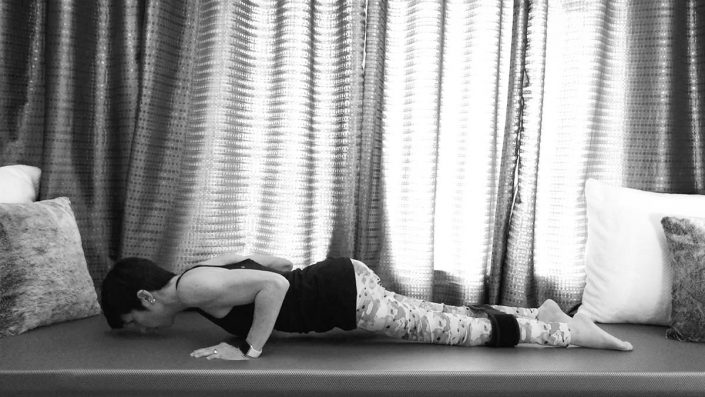
Push up triceps
• Main muscles: Triceps and pectorals / Secondary muscles: Stabilizers of the shoulder (large serrated and ...)
• Start: Hands at shoulder width, hands under the shoulders
• Movement: Bring the chest down to the ground, nose directed to the fingertips, elbows stuck to the body
• Tip # 1: Make sure you do not pinch your shoulder blades while descending. Instead, keep the shoulder blades wide for better stability. Do the exercise "Push up scap" to work the stability of the shoulder.
• Tip # 2: Perform some exercises with free weights before undertaking the body-based exercises (which are much more physically demanding).
• 3 x 5 reps to start. Increase the number of repetitions when the movement seems easier.
• Start: Hands at shoulder width, hands under the shoulders
• Movement: Bring the chest down to the ground, nose directed to the fingertips, elbows stuck to the body
• Tip # 1: Make sure you do not pinch your shoulder blades while descending. Instead, keep the shoulder blades wide for better stability. Do the exercise "Push up scap" to work the stability of the shoulder.
• Tip # 2: Perform some exercises with free weights before undertaking the body-based exercises (which are much more physically demanding).
• 3 x 5 reps to start. Increase the number of repetitions when the movement seems easier.
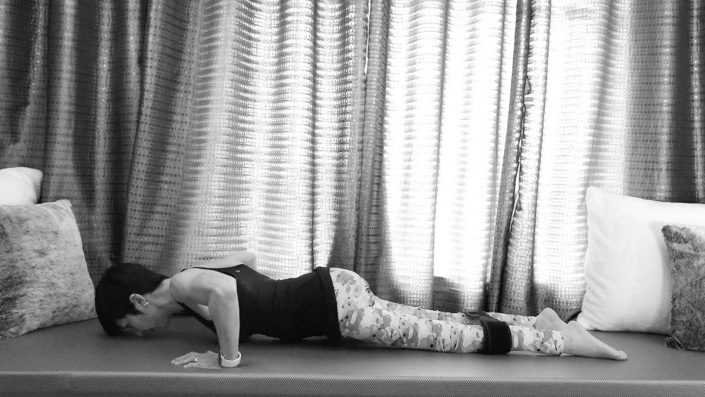
Push up
• Main muscles: Triceps and pectorals / Secondary muscles: Stabilizers of the shoulder (large serrated and anterior deltoid)
• Start: Hands at shoulder width, hands under the shoulders
• Movement: Bring the chest down to the ground, nose directed to the fingertips, elbows open to the outside
• Tip # 1: Make sure you do not pinch your shoulder blades while descending. Instead, keep the shoulder blades wide for better stability. Do the exercise "Push up scap" to work the stability of the shoulder.
• Tip # 2: Perform some exercises with free weights before undertaking the body-based exercises (which are much more physically demanding).
• 3 x 5 reps to start. Increase the number of repetitions when the movement seems easier.
• Start: Hands at shoulder width, hands under the shoulders
• Movement: Bring the chest down to the ground, nose directed to the fingertips, elbows open to the outside
• Tip # 1: Make sure you do not pinch your shoulder blades while descending. Instead, keep the shoulder blades wide for better stability. Do the exercise "Push up scap" to work the stability of the shoulder.
• Tip # 2: Perform some exercises with free weights before undertaking the body-based exercises (which are much more physically demanding).
• 3 x 5 reps to start. Increase the number of repetitions when the movement seems easier.
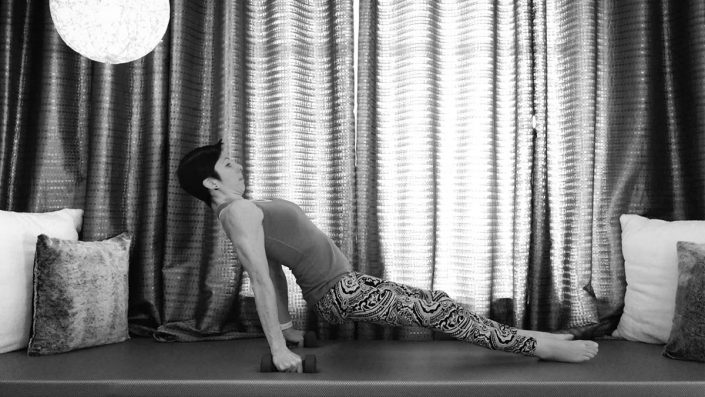
Balance of the back
• Main muscles: Back muscles and shoulder blade stabilizers
• Start: Fists on the bench and arm in full extension. Very low shoulder blades (they will have to remain like this during the whole exercise).
• Movement: First lift the buttocks by pushing into the ground with your fists. Then push the buttocks forward and towards the ceiling using the back muscles (like a pendulum).
• Tip # 1: Depending on your arm length, you may be able to use the palms of your hand to rest on the bench instead of using your fists. You can also use free weights to take support as in the video.
• Tip # 2: If you have sensations in your glutes, you can also contract them when you push the pelvis to the ceiling.
• Start: Fists on the bench and arm in full extension. Very low shoulder blades (they will have to remain like this during the whole exercise).
• Movement: First lift the buttocks by pushing into the ground with your fists. Then push the buttocks forward and towards the ceiling using the back muscles (like a pendulum).
• Tip # 1: Depending on your arm length, you may be able to use the palms of your hand to rest on the bench instead of using your fists. You can also use free weights to take support as in the video.
• Tip # 2: If you have sensations in your glutes, you can also contract them when you push the pelvis to the ceiling.
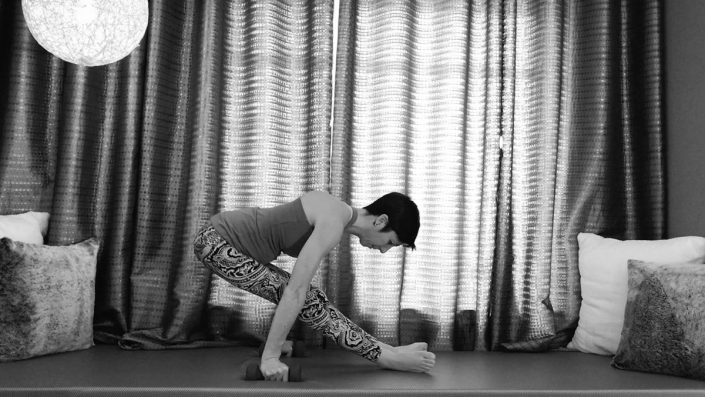
Balance of the shoulders
• Main Muscles: Median Deltoids and Scapula Stabilizers
• Start: Fists on the bench and arm in full extension. Very low shoulder blades (they will have to remain like this during the whole exercise).
• Movement: First lift the buttocks by pushing into the ground with your fists. Then push the buttocks backwards and towards the ceiling using the muscles of the shoulders (like a pendulum).
• Tip # 1: Depending on your arm length, you may be able to use the palms of your hand to rest on the bench instead of using your fists. You can also use free weights to take support as in the video.
• Tip # 2: If you have sensations in your abs, you can also contract them as you push the pelvis to the ceiling.
• Start: Fists on the bench and arm in full extension. Very low shoulder blades (they will have to remain like this during the whole exercise).
• Movement: First lift the buttocks by pushing into the ground with your fists. Then push the buttocks backwards and towards the ceiling using the muscles of the shoulders (like a pendulum).
• Tip # 1: Depending on your arm length, you may be able to use the palms of your hand to rest on the bench instead of using your fists. You can also use free weights to take support as in the video.
• Tip # 2: If you have sensations in your abs, you can also contract them as you push the pelvis to the ceiling.
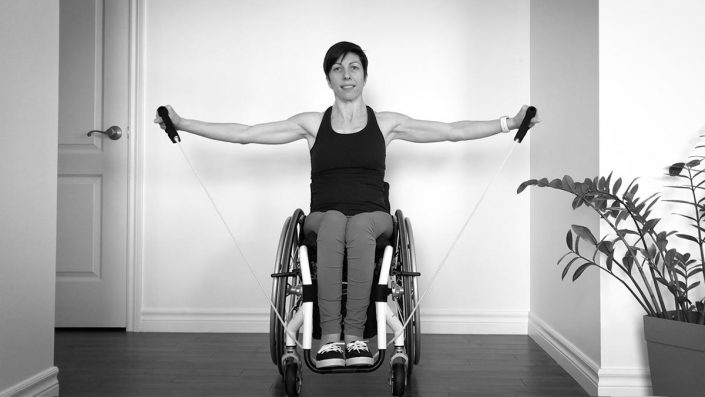
Abduction rebounds
• Main muscle: Median Deltoids
• Start: Run the elastic band under the footrest. Raise your arms at shoulder height.
• Movement: Bounce with the rubber band, making sure that your hands are constantly coming back to your shoulders (this will ensure constant resistance in the exercise).
• Tip: Use the chest belt if you ever feel unbalanced forward when moving.
• 3 x 30 seconds
• Start: Run the elastic band under the footrest. Raise your arms at shoulder height.
• Movement: Bounce with the rubber band, making sure that your hands are constantly coming back to your shoulders (this will ensure constant resistance in the exercise).
• Tip: Use the chest belt if you ever feel unbalanced forward when moving.
• 3 x 30 seconds
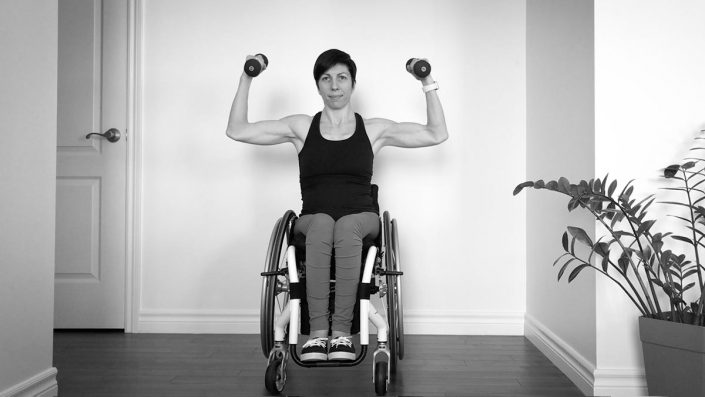
Biceps curl
• Main muscles: Biceps
• Start: Arms stretched out and fully extended, palms of hands directed towards the ceiling. Hands at the height of the shoulders.
• Movement: Bend your elbows up to a 90° angle and back down until your elbows are fully extend.
• Tip: Keep your shoulders low at all times
• Start: Arms stretched out and fully extended, palms of hands directed towards the ceiling. Hands at the height of the shoulders.
• Movement: Bend your elbows up to a 90° angle and back down until your elbows are fully extend.
• Tip: Keep your shoulders low at all times
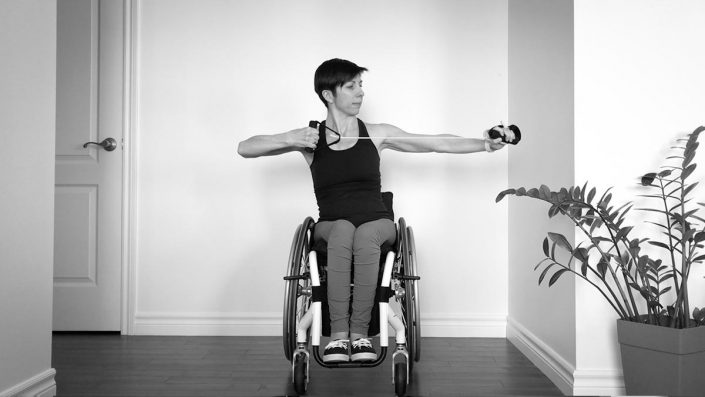
Archer
• Main Muscles: Posterior Deltoids and Biceps
• Start: Left arm in full extension, hand at shoulder height (as if holding a bow in your hand).
• Movement: Pull your right hand towards the shoulder. Stop the tirade of the rubber band before the wrist breaks.
• Tip: Constant look towards the left hand. Keep both hands at shoulder height.
• Start: Left arm in full extension, hand at shoulder height (as if holding a bow in your hand).
• Movement: Pull your right hand towards the shoulder. Stop the tirade of the rubber band before the wrist breaks.
• Tip: Constant look towards the left hand. Keep both hands at shoulder height.
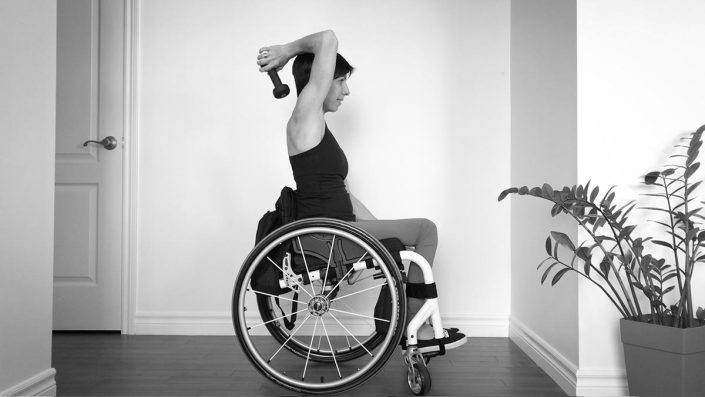
Triceps extension
• Main muscle: triceps
• Start: Hold the free weight with one hand behind the head. Keep the elbow close to the ear
• Movement: Bend the elbow 90° and pull the free weight until the full extension of the arm. Keep the weight constantly behind the head.
• Tip: The elbow must remain static at all times. It's only the forearm that has to move. If you have enough balance, you can perform both arms at the same time.
• Start: Hold the free weight with one hand behind the head. Keep the elbow close to the ear
• Movement: Bend the elbow 90° and pull the free weight until the full extension of the arm. Keep the weight constantly behind the head.
• Tip: The elbow must remain static at all times. It's only the forearm that has to move. If you have enough balance, you can perform both arms at the same time.
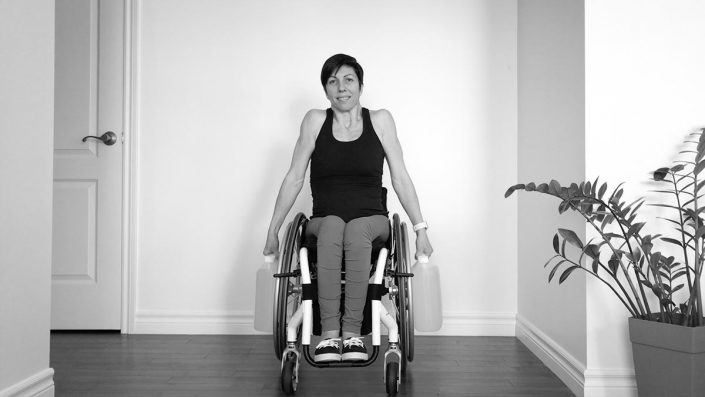
Shrug
• Main muscles: Trapezius
• Start: Arms stretched in full extension
• Movement: Pull up the shoulders towards the ears while keeping the arms extended
• Tip: At the end of the movement, to lower your shoulders, imagine that you want to bring your hands closer to the floor. Use heavier loads for this movement (ex: 2 bottles of 4 liters)
• Start: Arms stretched in full extension
• Movement: Pull up the shoulders towards the ears while keeping the arms extended
• Tip: At the end of the movement, to lower your shoulders, imagine that you want to bring your hands closer to the floor. Use heavier loads for this movement (ex: 2 bottles of 4 liters)
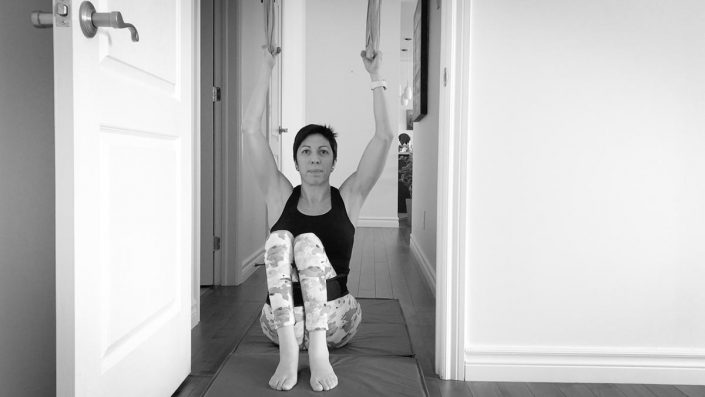
Rowing #2
• Main Muscles: Latissimus Dorsi and Biceps / Secondary Muscles: Forearm Muscles and Trapezius
• Start: Arm in full extension, palms of hand towards the face
• Movement: Pull the body weight upwards until the chin is facing the hands
• Tip # 1: Slow downhill by counting 6-8 seconds to build muscle strength.
• Tip # 2: If the exercise is too difficult, start with rowing # 1
• Start: Arm in full extension, palms of hand towards the face
• Movement: Pull the body weight upwards until the chin is facing the hands
• Tip # 1: Slow downhill by counting 6-8 seconds to build muscle strength.
• Tip # 2: If the exercise is too difficult, start with rowing # 1
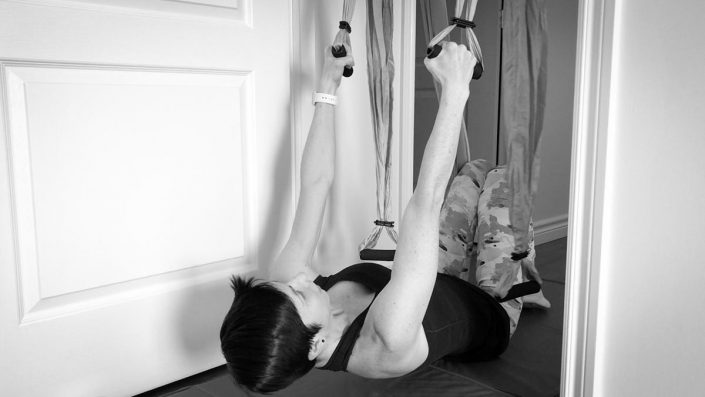
Rowing #1
• Main Muscles: Latissimus Dorsi and Biceps / Secondary Muscles: Forearm Muscles and Trapezius
• Start: Arm in full extension, palms facing each other
• Movement: Pull the body weight upwards until the chest is facing the hands.
• Tip # 1: Avoid pulling shoulders to the ears. Point the elbows backwards for proper movement alignment.
• Tip # 2: Slow downhill by counting 6-8 seconds to build muscle strength
• Start: Arm in full extension, palms facing each other
• Movement: Pull the body weight upwards until the chest is facing the hands.
• Tip # 1: Avoid pulling shoulders to the ears. Point the elbows backwards for proper movement alignment.
• Tip # 2: Slow downhill by counting 6-8 seconds to build muscle strength
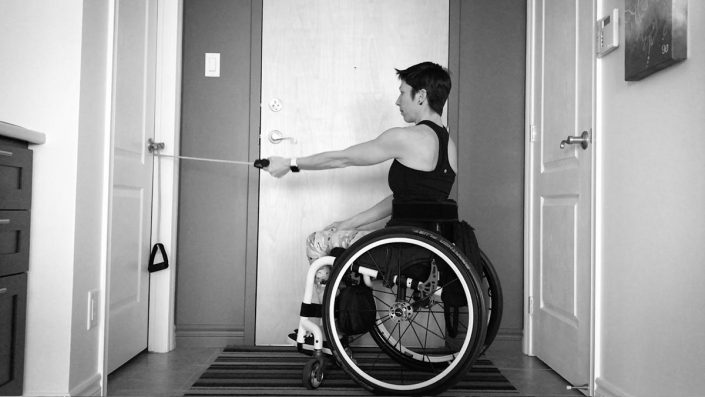
Shoulder extension (one arm)
• Main muscle: Latissimus Dorsi, extensors of the forearm and triceps / Secondary muscles: Posterior Deltoids
• Start: Initially, the arm must be stretched forward with a slight resistance in the elastic. Position the chair so that the arm is perpendicular to the attach.
• Movement: Palm of hand directed forward, arm extended. Pull the elastic band down and back. Control and slow down the movement back
• Tip: Rest on the thigh with your free hand.
• Start: Initially, the arm must be stretched forward with a slight resistance in the elastic. Position the chair so that the arm is perpendicular to the attach.
• Movement: Palm of hand directed forward, arm extended. Pull the elastic band down and back. Control and slow down the movement back
• Tip: Rest on the thigh with your free hand.
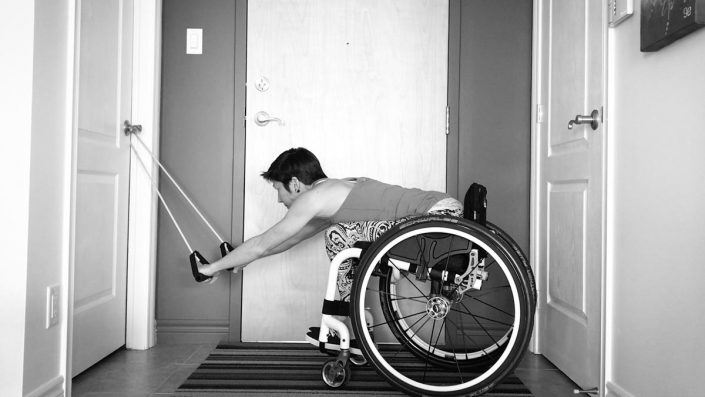
Shoulder extension
• Main Muscle: Latissimus Dorsi / Secondary Muscle: Posterior Deltoids
• Start: Attach the elastic at the door. Position the chair facing the attach. In the starting position, the arms must be elongated in front and the elastic must be slightly tensioned.
• Movement: Pull the elastic band down and back while keeping the arms fully extended
• Caution: Test assisted movement before running alone to avoid falls. The elastic tends to pull you forward in this movement.
• Start: Attach the elastic at the door. Position the chair facing the attach. In the starting position, the arms must be elongated in front and the elastic must be slightly tensioned.
• Movement: Pull the elastic band down and back while keeping the arms fully extended
• Caution: Test assisted movement before running alone to avoid falls. The elastic tends to pull you forward in this movement.
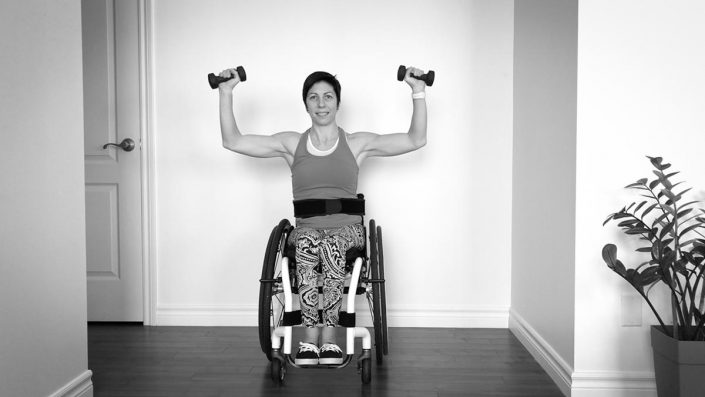
Shoulder press
• Main Muscles: Deltoids / Secondary Muscles: Triceps
• Start: Elbows bent at 90° at shoulders height, palms pointing forward
• Movement: Push the loads towards the ceiling until the full extension of the elbows (arms near the ears)
• Tip: Control the descent for better control of the exercise. Keep the shoulder blades low at all times.
• Start: Elbows bent at 90° at shoulders height, palms pointing forward
• Movement: Push the loads towards the ceiling until the full extension of the elbows (arms near the ears)
• Tip: Control the descent for better control of the exercise. Keep the shoulder blades low at all times.
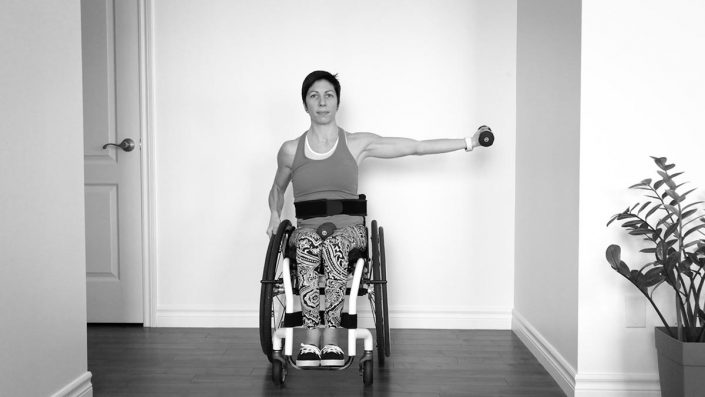
Shoulder abduction
• Main muscle: Deltoids
• Departure: Palm of hand towards the ceiling and arm extended. Take support on the chair with your free hand
• Movement: Raise the arm towards the ceiling until it is glued close to the ear. Go back down horizontally
• Tip: If you have enough balance, you can perform both arms at the same time.
• Departure: Palm of hand towards the ceiling and arm extended. Take support on the chair with your free hand
• Movement: Raise the arm towards the ceiling until it is glued close to the ear. Go back down horizontally
• Tip: If you have enough balance, you can perform both arms at the same time.
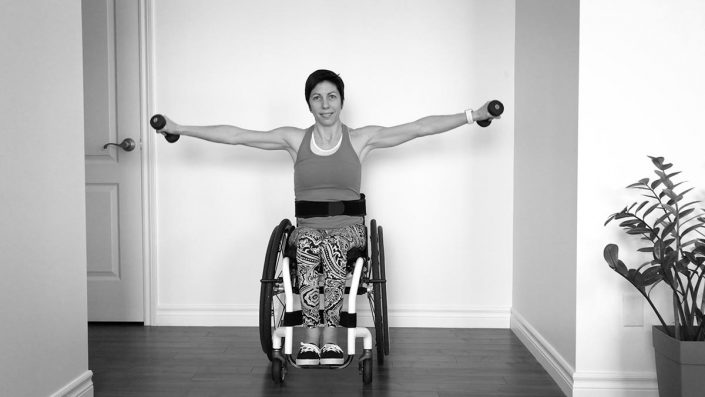
Shoulder abduction
• Main muscles: Median Deltoids
• Start: Arms stretched and fully extended, palms of hands directed to the floor
• Movement: Raise arms to shoulder height and back down
• Tip: Slow motion downhill for better control, keep the shoulders low at all times
• Start: Arms stretched and fully extended, palms of hands directed to the floor
• Movement: Raise arms to shoulder height and back down
• Tip: Slow motion downhill for better control, keep the shoulders low at all times
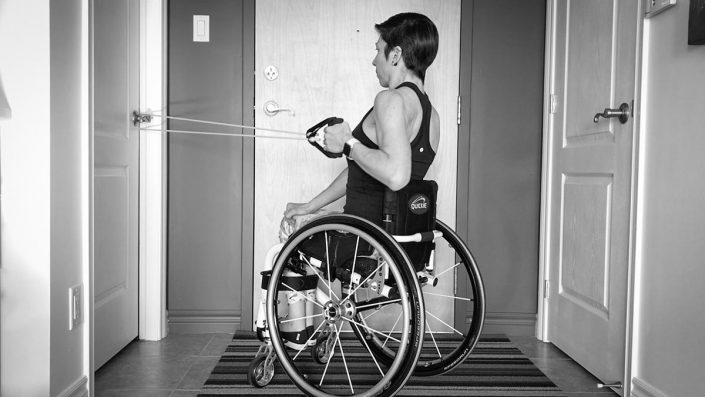
Rowing one arm with shoulder protract/retract
• Main muscle: Latissimus Dorsi, lower trapezius and rhomboid / Secondary muscles: Biceps
• Start: Hold the 2 handles of the elastic together, arms outstretched
• Movement: Make a protraction followed by a retraction of the scapula. Then pull your elbow backwards, bringing your hand close to your chest. Resume the sequence
• Start: Hold the 2 handles of the elastic together, arms outstretched
• Movement: Make a protraction followed by a retraction of the scapula. Then pull your elbow backwards, bringing your hand close to your chest. Resume the sequence
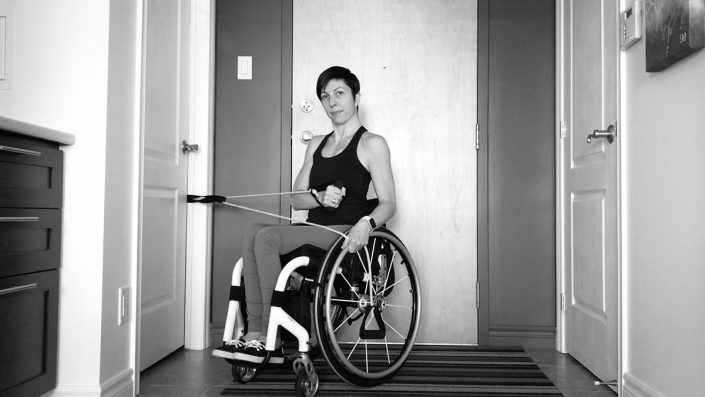
Internal rotation
• Main muscles: Rotator cuff (large round and subscapular)
• Start: Elbow at 90° and glued along the body. Place your chair close enough to the anchor at the start. The anchor should be as much as possible at the same height as the elbow.
• Movement: Hold the elastic by the handle. Begin the movement with the forearm open outward and pull inward without the elbow coming off the body.
• Tip: A small movement is enough ... the bottom line is that the elbow is stable. Take support on the chair with your free hand
• Start: Elbow at 90° and glued along the body. Place your chair close enough to the anchor at the start. The anchor should be as much as possible at the same height as the elbow.
• Movement: Hold the elastic by the handle. Begin the movement with the forearm open outward and pull inward without the elbow coming off the body.
• Tip: A small movement is enough ... the bottom line is that the elbow is stable. Take support on the chair with your free hand
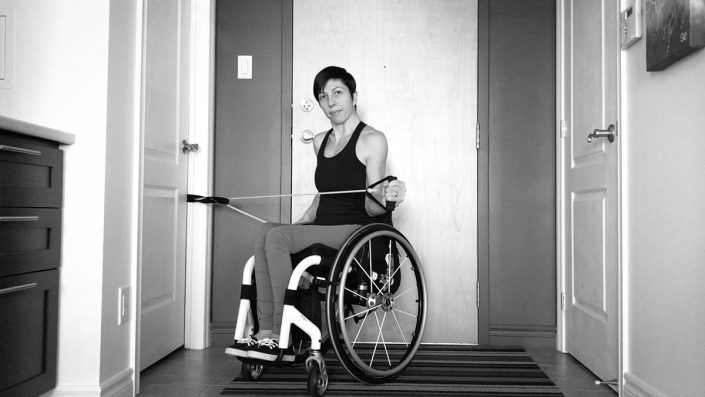
External rotation
• Main muscles: Rotator cuff (Teres minor, infraspinatus)
• Start: Elbow at 90° and glued along the body. Place your chair close enough to the anchor at the start. The anchor should be as much as possible at the same height as the elbow.
• Movement: Hold the elastic by the handle. Begin the movement with the arm close to the body and open outward without the elbow coming off the body.
• Tip: A small movement is enough ... the bottom line is that the elbow is stable. Take support on the chair with your free hand
• Start: Elbow at 90° and glued along the body. Place your chair close enough to the anchor at the start. The anchor should be as much as possible at the same height as the elbow.
• Movement: Hold the elastic by the handle. Begin the movement with the arm close to the body and open outward without the elbow coming off the body.
• Tip: A small movement is enough ... the bottom line is that the elbow is stable. Take support on the chair with your free hand
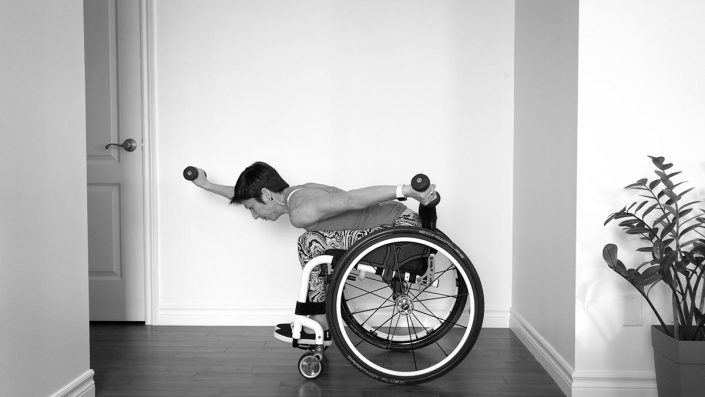
The swimmer
• Main muscles: Latissimus dorsi and deltoids / Secondary muscles: Trapezius
• Start: Arms upright, free weights near the ground, palms of hands facing backwards
• Movement: Raise one arm forward and the other back. Arm in extension at all times. Go back down and reverse the movement
• Tip: Control and slow down speed when lowering arms
• Start: Arms upright, free weights near the ground, palms of hands facing backwards
• Movement: Raise one arm forward and the other back. Arm in extension at all times. Go back down and reverse the movement
• Tip: Control and slow down speed when lowering arms
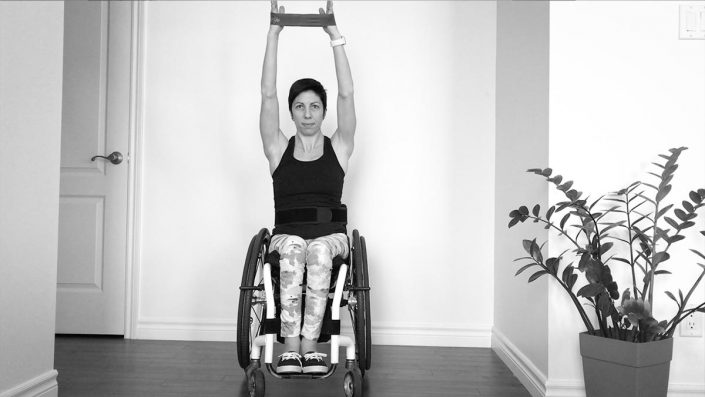
Shoulder flexion and rotations
• Main Muscles: Posterior Deltoids and Rotator Cuff / Secondary Muscles: Trapezius
• Start: Put your hands in the elastic and keep a constant tension (wanting to keep your hands away from each other). Arms extended at all times
• Movement in combination: Make 2 semicircles, raise arms vertically, raise and lower the shoulders, and bring the arms back to the horizontal
• Tip: The 2 movements can also be performed separately (rotations / shoulder movements). 1 repetition = 1 combination of movement
• Start: Put your hands in the elastic and keep a constant tension (wanting to keep your hands away from each other). Arms extended at all times
• Movement in combination: Make 2 semicircles, raise arms vertically, raise and lower the shoulders, and bring the arms back to the horizontal
• Tip: The 2 movements can also be performed separately (rotations / shoulder movements). 1 repetition = 1 combination of movement
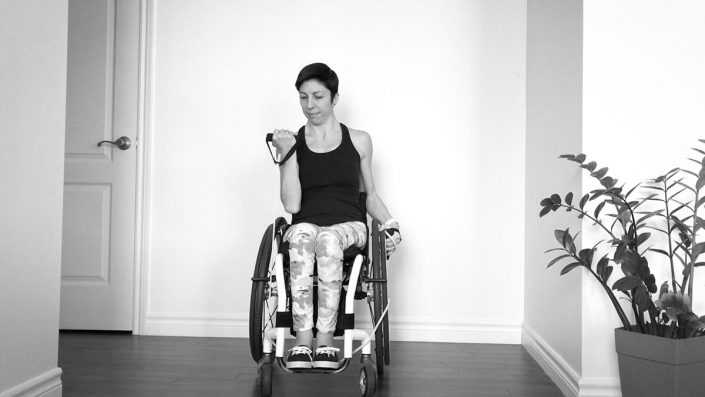
Biceps curl
• Main muscle: Biceps
• Start: Run the elastic under the wheels. Adjust the resistance with the opposite hand. The elastic must be in tension with the arm at 90°
• Movement: Stabilize the elbow close to the body. Flex your elbow and go back down to control
• Tip: Readjust the resistance of the elastic after a few repetitions to make sure to have a warmth in the muscle before the 10th repetition.
• Start: Run the elastic under the wheels. Adjust the resistance with the opposite hand. The elastic must be in tension with the arm at 90°
• Movement: Stabilize the elbow close to the body. Flex your elbow and go back down to control
• Tip: Readjust the resistance of the elastic after a few repetitions to make sure to have a warmth in the muscle before the 10th repetition.
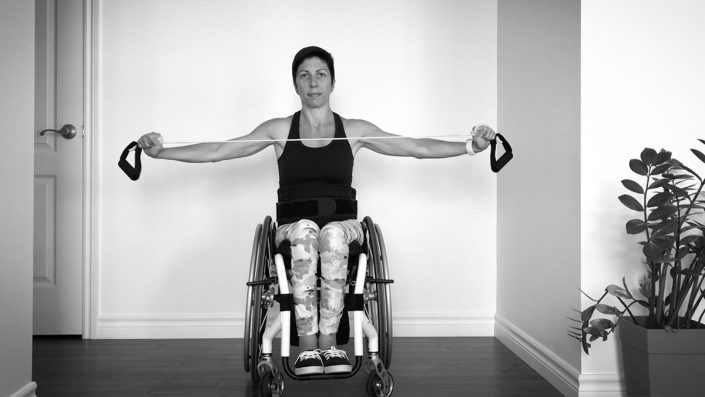
Reverse fly
• Main muscles: Posterior Deltoids / Secondary Muscles: Rhomboids
• Start: Open arm in V, arms extended and at shoulders height
• Movement: Pull the elastic by keeping your arms straight until it touches your chest
• Tip: Readjust the resistance after a few repetitions to ensure a good range of motion
• Start: Open arm in V, arms extended and at shoulders height
• Movement: Pull the elastic by keeping your arms straight until it touches your chest
• Tip: Readjust the resistance after a few repetitions to ensure a good range of motion
